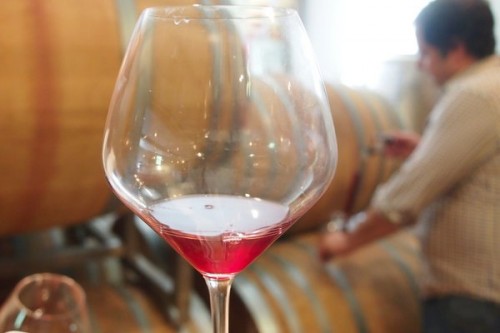
What’s the most interesting development in the world of wine? Single-variety Vinho Verde? Rosé in magnum? No, for me, it’s the rise of lighter-coloured red wines. And this is quite a new thing, and a big thing.
When I started out drinking wine seriously, back in the mid-1990s, bigger was best. The sorts of red wines that were celebrated were those that were inky-dark and concentrated. Dense, intense, opaque, practically black red wines were highly sought after, and landed the big point scores.
I was all over these big reds. For me, the ultimate red wine would have been one so thick you could stand a spoon in it. And as black as coal.
The wine world was in some sort of collective insanity, pursuing ripeness and concentration above everything else. This continued through the noughties. In Bordeaux, even – a region with a special talent for balanced, digestible reds – the wines began to get darker and richer.
There’s nothing intrinsically wrong with dark-coloured red wines. It’s just that all wines were moving further in this direction, and no one was the slightest bit interested in reds that were paler in colour.
How quickly this has changed! In the space of just a few years, wine lovers are beginning to realize that there is no correlation between depth of colour and wine quality. Pale reds don’t necessarily lack flavour; they seldom lack aroma. Just as there’s been a shift away from high alcohol, a corresponding shift is beginning with red wine colour.
A lot of the red wines I get excited about at the moment are decidedly pale in hue, and there are ever more of these lighter reds to choose from. Pinot Noir was never meant to make dark red wines: it’s pretty bonkers to do extended cold macerations and excessive punch downs in order to pull more colour out of a grape whose talent is for making lighter-coloured red wines. To use a rugby analogy, it’s like drafting your winger into the middle of the pack. Pinot is about elegance and aroma.
Historically, Bordeaux produced lighter-coloured reds, hence the term Claret. Bordeaux a region with a talent for midweight, balanced red wines which develop beautiful, haunting aromatics with age. Some of the top wines of today are just too dark and concentrated, and don’t play to the strengths of this region at all.
Gamay is a grape benefiting from this renewed interest in lighter reds. Suddenly, Beaujolais is being taken seriously – and not just the bigger, more structured examples, but also the lighter, more fragrant ones. Gamay is attracting interest elsewhere, too. gamay is a grape of the future.
Look at the rise of Cinsault, especially in South Africa. While it has been widely grown for its high yields and for retaining freshness in hot climates, Cinsault’s lack of colour was seen as a major problem. Not any more: ambitious young winemakers are seeing it as a valuable blending component, but also as a fabulous variety in its own right, able to make supremely drinkable red wines that are low in colour and alcohol.
Even with more mainstream varieties that typically make darker-coloured reds, many winemakers are deliberately extracting less. Working with whole bunches, being sparing with punchdowns and reducing maceration times: these are now common approaches for those looking for elegance and fragrance over power and density.
The thing about lighter reds? Well, there are a couple of things. First, they usually have such beautiful aromatics. It’s as if the lighter extraction allows a leap forward aromatically. Does colour shackle aroma in some strange way? The other thing is that you are always in the mood to drink them, and they are usually so amazingly drinkable.
Of course, lighter reds aren’t universally understood or appreciated. For now, they probably aren’t mainstream, but I’m predicting a bright future for them – both the fun, smashable ones, and also the more serious ones.
It’s a thing. Lighter coloured reds. The next thing? Darker coloured whites. This is beginning to happen, too.
9 Comments on The rise of the lighter-coloured red wine


We love our Pinot noir and Cinsault wines. The customers do also once they try them.
My guru once said to me ‘First and foremost, wine is a drink… for when you are thirsty’ Sounds obvious, but never a truer word said.
Nebbiolo or the harder to find Grignolino.
Jamie,
It is true that combinations of intensive cap wetting and pre/post ferment maceration have been used to deepen and stabilise colour. But what about the use of enzymes?
Colour enhancing enzymes (pectinases) are a widespread tool. They are used in old and new world wine regions. Here are a couple of links for readers who want to know more:
http://palatepress.com/2012/11/wine/making-wine-the-use-of-enzymes-in-modern-winemaking/
http://www.laffort.com/images/stories/telechargement/Laffort%20info/LI-ANG/LI-EN-Macerating-enzymes-and-fermentation-tannins.pdf
So we can put away the lallzyme exv and rapidase colour enzymes?
Nice work, Jamie. It’s an interesting thing – the relationship between color and intensity. I’ve definitely noticed this trend in California Pinot Noir over a handful of vintages. More and more wines are this cool rose color – still plenty of punch, but not so intensely dark. Cheers!
Well just look at some of the more aromatic northern Italian wines like Dry Brachetto, Ruche and others, light in color, high in aromatics and wonderful, but not like roses. Even some new Garnachas from the Vinos de Madrid area of Spain and many others. Finger Lakes and Alsatian Pinot Noir can almost be rose like in color, but be packed with flavor.
Try the Heart and Hands FL pinot. The color of rose, but not the palate.
Great piece, Jamie. In my market (California) we’ve seen a definite increase in interest in this kind of wine, which was hard to sell 15 years ago. Bardolino, Rossese di Dolceaqua, Grignolino, Piedirosso, Schiava, and others (I import Italian wine).
Agree with you Jamie on the trend and aromatics. I think Aussie Grenache has been a great beneficiary. Perhaps unshackled aronatics connected to use of whole berry, carbonic and whole bunch techniques and less if any oak? Also earlier picking if – and you would know – higher acidity has an impact on aroma which is my gut but very unscientific view!